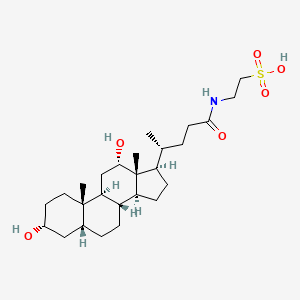| MeSH term | MeSH ID | Detail |
|---|---|---|
| Tay-Sachs Disease | D013661 | 2 associated lipids |
| Short Bowel Syndrome | D012778 | 3 associated lipids |
| Shock, Hemorrhagic | D012771 | 4 associated lipids |
| Gastroesophageal Reflux | D005764 | 10 associated lipids |
| Fetal Resorption | D005327 | 15 associated lipids |
| Pancreatitis, Acute Necrotizing | D019283 | 18 associated lipids |
| Cholestasis | D002779 | 23 associated lipids |
| Birth Weight | D001724 | 23 associated lipids |
| Colitis, Ulcerative | D003093 | 24 associated lipids |
| Gastrointestinal Hemorrhage | D006471 | 27 associated lipids |
Taurodeoxycholic acid
Taurodeoxycholic acid is a lipid of Sterol Lipids (ST) class. Taurodeoxycholic acid is associated with abnormalities such as Ischemia and Wiskott-Aldrich Syndrome. The involved functions are known as Cell Proliferation, Transcriptional Activation, Phosphorylation, Anabolism and Biochemical Pathway. Taurodeoxycholic acid often locates in Body tissue, Epithelium, Blood, Mucous Membrane and Hepatic. The associated genes with Taurodeoxycholic acid are NOX5 gene, GPBAR1 gene, NR1H4 gene and SLC33A1 gene. The related lipids are cholanic acid, taurolithocholic acid 3-sulfate, Sterols, 7-dehydrocholesterol and tauromuricholic acid.
Cross Reference
Introduction
To understand associated biological information of Taurodeoxycholic acid, we collected biological information of abnormalities, associated pathways, cellular/molecular locations, biological functions, related genes/proteins, lipids and common seen animal/experimental models with organized paragraphs from literatures.
What diseases are associated with Taurodeoxycholic acid?
Taurodeoxycholic acid is suspected in Ischemia and other diseases in descending order of the highest number of associated sentences.
Related references are mostly published in these journals:
| Disease | Cross reference | Weighted score | Related literature |
|---|
Possible diseases from mapped MeSH terms on references
We collected disease MeSH terms mapped to the references associated with Taurodeoxycholic acid
PubChem Associated disorders and diseases
What pathways are associated with Taurodeoxycholic acid
There are no associated biomedical information in the current reference collection.
PubChem Biomolecular Interactions and Pathways
Link to PubChem Biomolecular Interactions and PathwaysWhat cellular locations are associated with Taurodeoxycholic acid?
Visualization in cellular structure
Associated locations are in red color. Not associated locations are in black.
Related references are published most in these journals:
| Location | Cross reference | Weighted score | Related literatures |
|---|
What functions are associated with Taurodeoxycholic acid?
Related references are published most in these journals:
| Function | Cross reference | Weighted score | Related literatures |
|---|
What lipids are associated with Taurodeoxycholic acid?
Related references are published most in these journals:
| Lipid concept | Cross reference | Weighted score | Related literatures |
|---|
What genes are associated with Taurodeoxycholic acid?
Related references are published most in these journals:
| Gene | Cross reference | Weighted score | Related literatures |
|---|
What common seen animal models are associated with Taurodeoxycholic acid?
There are no associated biomedical information in the current reference collection.
NCBI Entrez Crosslinks
All references with Taurodeoxycholic acid
Download all related citations| Authors | Title | Published | Journal | PubMed Link |
|---|---|---|---|---|
| GarcÃa-Arnandis I et al. | Control of cell migration and inflammatory mediators production by CORM-2 in osteoarthritic synoviocytes. | 2011 | PLoS ONE | pmid:21961038 |
| Trottier J et al. | Profiling circulating and urinary bile acids in patients with biliary obstruction before and after biliary stenting. | 2011 | PLoS ONE | pmid:21760958 |
| Dai J et al. | Impact of bile acids on the growth of human cholangiocarcinoma via FXR. | 2011 | J Hematol Oncol | pmid:21988803 |
| Halin J and Mattjus P | Effects of bile salts on glucosylceramide containing membranes. | 2011 | Biochim. Biophys. Acta | pmid:21910967 |
| Lunelli M et al. | Crystal structure of PrgI-SipD: insight into a secretion competent state of the type three secretion system needle tip and its interaction with host ligands. | 2011 | PLoS Pathog. | pmid:21829362 |
| Zahiri HR et al. | Bile salt supplementation acts via the farnesoid X receptor to alleviate lipopolysaccharide-induced intestinal injury. | 2011 | Surgery | pmid:21878234 |
| Martin NA et al. | Active transport of bile acids decreases mucin 2 in neonatal ileum: implications for development of necrotizing enterocolitis. | 2011 | PLoS ONE | pmid:22162748 |
| Ngamukote S et al. | Cholesterol-lowering activity of the major polyphenols in grape seed. | 2011 | Molecules | pmid:21694670 |
| Kaddurah-Daouk R et al. | Enteric microbiome metabolites correlate with response to simvastatin treatment. | 2011 | PLoS ONE | pmid:22022402 |
| Zhang Y et al. | Loss of organic anion transporting polypeptide 1a1 increases deoxycholic acid absorption in mice by increasing intestinal permeability. | 2011 | Toxicol. Sci. | pmid:21914718 |
